
Robotisation can catalyse trade and improve welfare, but policies are required to ensure automation-induced growth is inclusive
Modern industrial robots can perform a variety of repetitive tasks with consistent precision and are increasingly used in a wide range of industries and applications. Global sales of industrial robots reached a new record of 387,000 units last year (IFR 2018) and robot adoption is projected to grow steadfastly. The accelerating automation of production has stoked fears that large swaths of the workforce, especially the unskilled, may suffer wage and job losses (Bloom et al. 2018).
These fears are in part predicated on the experience of OECD countries, where robot adoption has contributed to productivity growth at the expense of the employment share of low-skilled workers (Acemoglu and Restrepo 2017, Graetz and Michaels 2018). Recent estimates suggest that around 14% of jobs across the OECD area are at risk of disappearing because of automation, while another 32% are likely to see significant changes (OECD 2018).
Robotisation and North-South trade
But it’s not only workers in rich countries that are potentially at risk. Those in developing countries could also be in peril. Robotisation might reduce the scope for North-South trade and incentivise production closer to home, thus undermining the prospects for export-led development (Hallward-Driemeier and Nayyar 2018).
Developing countries are arguably especially exposed to automation-induced trade declines, since globalisation has been associated with the offshoring of repetitive and labour-intensive tasks to low wage countries (Das 2018, Mittali and Das 2018). Moreover, developing countries may not have the requisite skills and infrastructure to meaningfully participate in future global value chains, as automation diminishes the importance of low labour costs as a determinant of competitiveness (Rodrik 2018).
The study: The impact of robatisation on the South
In our recent research (Artuc et al. 2018) we show that, at least for now and for the foreseeable future, these fears about Northern automation hurting Southern workers are vastly overblown. On the contrary, Northern robotisation promotes North-South trade and is likely to benefit workers and consumers in developing countries.
Robot adoption: Cost of labour and technological feasibility
We start by assessing what drives robot adoption (Figure 1). Potential cost savings seem to be an important determinant since richer countries, where both wages and the opportunity cost of labour are higher, tend to adopt more robots (Panel a). In addition, the technological feasibility of automation (as measured by the share of jobs that could be performed by robots) is an important driver of robot use across different industries (Panel b).
Figure 1 Drivers of robot adoption
a) Robot adoption is associated with the (opportunity) cost of labour
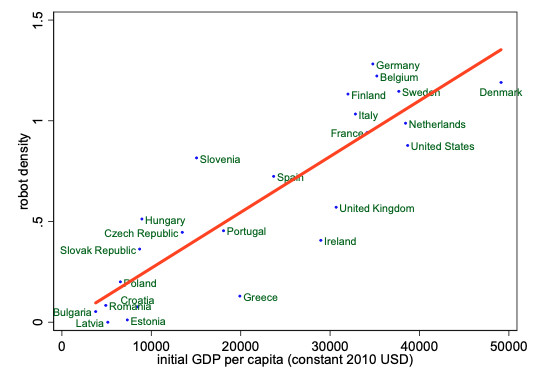
b) Sectors in which automation is feasible adopt more robots
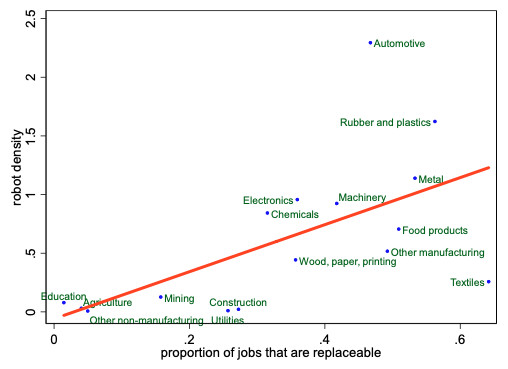
Automation and North-South trade
We then document the impact automation has had on bilateral industry-level North-South trade over the past two decades. Using an instrumental variable strategy that exploits variation in exposure to robots across countries and sectors, we find that a 10% increase in robot density in an automating industry in the North boosts its exports to the South by 11.8%. Surprisingly, it also induces a 6.1% increase in its imports from the South.
Explaining the benefits of robotisation
What explains these patterns? To answer this question, we develop a trade model featuring two-stage production and trade in both intermediate and final goods in which some – but not all – tasks can potentially be automated in some sectors. The increased exports from the North are easily explained by robot-induced reductions in production costs.
The more striking growth in imports from the South reflects the sum of two competing forces:
- On the one hand, lower costs in the North make domestic producers and input suppliers there more competitive relative to foreign ones, which lowers the demand for goods produced abroad.
- On the other hand, the expansion of production in the North also leads to an overall surge in the demand for intermediate inputs. If these are sourced from abroad, imports from the South in these industries can rise.
Over the past 20 years, the latter production expansion effect seems to have dominated. Indeed, our empirical results reveal that the robot-induced surge in Northern imports from the South is concentrated in intermediate inputs such as parts and components.
Implications
Given these patterns, how are further reductions in robot prices likely to impact global trade, wages and welfare? To answer this question, we calibrate our model considering a representative rich Northern country, a representative Southern country, and a third country (“Other”), which represents all other countries (and is poorer than the North yet richer than the South).
Simulating the impact of future reductions in robot prices offers several interesting insights (Figure 2):
Robotisation
- North: As robot prices decline, producers in the North, which face higher wages, will adopt progressively more robots (Panel a).
- South: When prices decline even further it also becomes profitable for less developed countries, where producers face lower labour costs, to robotise production.
Labour allocation
- Robot adoption is associated with an initial reduction in the number of jobs in the automating sector (Panel b). Yet, the impact of robot price reductions on employment is non-linear.
- Once all tasks that can be automated are performed by robots, further reductions in robot prices boost the demand for labour in the robotised sector, because they make workers in those sectors more productive.
- While robots compete with workers in the early stages of adoption, they complement them in subsequent stages.
Wages
- North and “Other”: A U-shaped relationship between robot prices and labour demand (and, by implication, wages) is generated (Panel c).
- Interestingly, workers in the South enjoy increases in real wages.
Welfare
- As robot prices fall, aggregate welfare increases in all countries, but more so in the countries that adopt more robots (Panel d).
Trade
- As Northern producers demand progressively more intermediate inputs to enable their expansion of production, their demand for Southern exports of intermediates surges.
Figure 2 Effects of robot price reductions on robot use, labour allocation, wages and welfare
a) Robot use
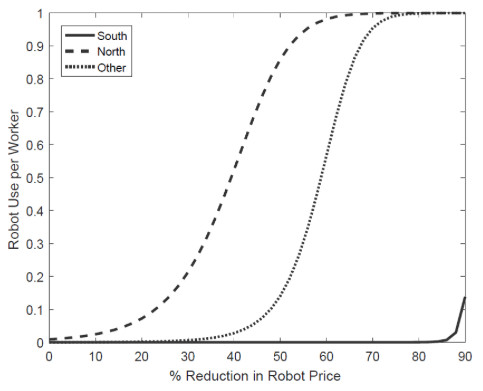
b) Labour allocation
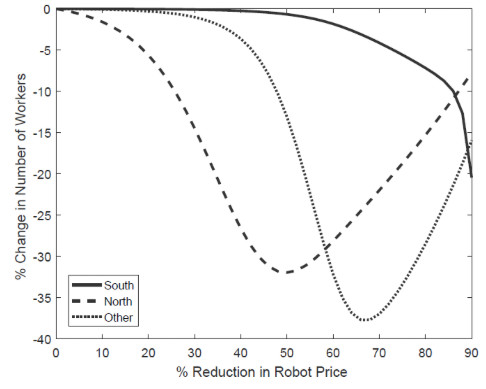
c) Wages
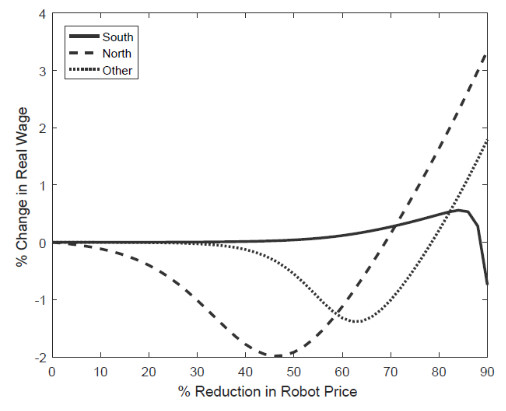
d) Welfare
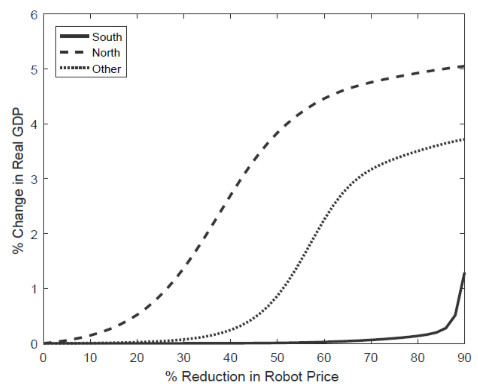
Conclusion: Realising inclusive technological growth
In summary, industrial robots will most likely catalyse, rather than reduce, North-South trade and enhance global welfare. This conclusion is likely to be reinforced by the fact that other new technologies – such as high-speed internet, blockchain, and digital platforms – will reduce even further the costs of trading and coordinating across borders (Freund and Weinhold 2002, 2004, Brynjolfsson, Hui and Liu 2018); and can lead to the creation of new products and tasks (Acemoglu and Restrepo 2018, Nakamura and Zeira 2018).
At the same time, trade and technological change will necessitate labour market adjustment and may create severe distributional tensions. Designing policies that harness the growth potential of globalisation and technological progress whilst ensuring the attendant gains are equitably spread is, therefore, an important task for future human research.
References
Acemoglu, D and Restrepo, P (2018). “The Race between Man and Machine: Implications of Technology for Growth, Factor Shares, and Employment”, American Economic Review 108(6): 1488–1542.
Acemoglu, D and Restrepo, P (2017). “Robots and Jobs: Evidence from US Labor Markets”, Unpublished manuscript.
Artuc, E, Bastos, P and Rijkers, B (2018). "Robots, Tasks and Trade", World Bank Policy Research Working Paper 8674.
Bloom, D, McKenna, M and Prettner, K (2018). “Demography, unemployment, and automation: Challenges in creating (decent) jobs until 2030”, VoxEU, 17 December.
Brynjolfsson, E, Hui, X and Liu, M (2018). “Does Machine Translation Affect International Trade? Evidence from a Large Digital Platform”, NBER Working Paper 24917.
Coelli, F, Moxnes, A and Ulltveit-Moe, K (2016). “Better, Faster, Stronger: Global Innovation and Trade Liberalization”, NBER Working Paper No. 22647.
Das, M (2018). “Automation and job displacement in emerging markets: New evidence”, VoxEU, 13 November.
Das, M and Hilgenstock, B (2018). "The Exposure to Routinization: Labor Market Implications for Developed and Developing Economies", IMF Working Paper WP/18/135.
Freund, C and Weinhold, D (2002). “The Internet and International Trade in Services”, American Economic Review Papers & Proceedings, 92(2): 236-240.
Freund, C and Weinhold, D (2004). “The Effect of the Internet on International Trade”, Journal of International Economics, 62(1): 171–189.
Graetz, G and Michaels, G (2018). “Robots at Work”, Review of Economics and Statistics, forthcoming.
Hallward-Driemeier, M and Nayar, G (2018). Trouble in the Making? The Future of Manufacturing-Led Development, World Bank, Washington DC.
International Federation of Robotics (2018). World Robotics 2018 Industrial Robots.
Nakamura, H and Zeira, J (2018). “Automation and unemployment: Help is on the way”, VoxEU, 11 December.
Organisation for Economic Co-operation and Development/OECD (2018). Job Creation and Local Economic Development 2018.



